
Architecture of the Paris Métro
Encyclopedia

Paris Métro
The Paris Métro or Métropolitain is the rapid transit metro system in Paris, France. It has become a symbol of the city, noted for its density within the city limits and its uniform architecture influenced by Art Nouveau. The network's sixteen lines are mostly underground and run to 214 km ...
comprises 300 stations and 384 train halls (2009). From the original plain white tilework and art nouveau entrances, station decoration has evolved with successive waves of building and renovation.
After experiments with diverse colour schemes, furniture and lighting, since 1999 the programme Renouveau du Métro has seen a reversion to the original design principles of the network. In parallel, line 14
Paris Metro Line 14
Line 14 of the Paris Métro system connects the stations Saint Lazare and Olympiades on a north-west south-east diagonal across the centre of Paris. It is the twelfth busiest of sixteen lines on the network, and as of 2011, the only one to be operated completely automatically; the second such line...
has provided an entirely new template for the stations of the 21st century.
Entrances
As with all subway systems, Métro entrances are designed firstly to be visible and recognisable. They feature at least a column and a network map. Decorative styles have changed over the years.Original Guimard style
In 1899 the Compagnie du chemin de fer métropolitain de ParisCompagnie du chemin de fer métropolitain de Paris
The Compagnie du chemin de fer métropolitain de Paris , or CMP, was the forerunner of the RATP, the company managing the Parisian subway.- Origin :...
launched a competition for the street architecture of the soon-to-be-opened Métro. The winner of the competition was architect Henri Duray In view of avoiding conflicts with the municipality, the CMP's president, Adrien Bénard initially favored the municipality architect Jean-Camille Formigé
Jean-Camille Formigé
Jean-Camille Formigé was a French architect. His son was Jules Formigé.-Projects:*Austerlitz Viaduct *Bir-Hakeim Viaduct *Metro Line 2 Viaduct, Paris -Notes:...
. Later he proposed the art nouveau
Art Nouveau
Art Nouveau is an international philosophy and style of art, architecture and applied art—especially the decorative arts—that were most popular during 1890–1910. The name "Art Nouveau" is French for "new art"...
architect Hector Guimard
Hector Guimard
Hector Guimard was an architect, who is now the best-known representative of the French Art Nouveau style of the late nineteenth and early twentieth centuries....
, which was agreed by the municipality.
Two types
Guimard designed two types of entrance, with and without glass roofs. Built in cast iron, they make heavy reference to the symbolism of plants. 141 entrances were constructed between 1900 and 1912, of which 86 still exist.The roofed variety, known as édicules (kiosks) feature a fan-shaped glass awning and an enclosure of opaque panelling decorated in floral motifs. The most imposing of these were built at Étoile
Charles de Gaulle - Étoile (Paris Metro and RER)
Charles de Gaulle – Étoile is a station on Paris Métro Line 1 and of the RER urban rail network. It lies on the boundary of the VIIIe and XVIIe arrondissements of Paris...
and Bastille
Bastille (Paris Metro)
Bastille is a station on lines 1, 5 and 8 of the Paris Métro. It is located near the former location of the Bastille and remains of the Bastille can be seen on line 5. The platforms for line 1 are situated below road level but above the Basin of the Arsenal and Canal Saint Martin in a short-open...
, on opposite sections of the inaugural line 1
Paris Metro Line 1
Paris Métro Line 1 is one of the sixteen lines composing the Paris Métro . It connects the La Défense – Grande Arche and Château de Vincennes stations. With a 16.5 km length, it constitutes an "East-West" route transportation important for the City of Paris...
. Both of these were torn down in the 1960s. Today only two édicules survive, at Porte Dauphine
Porte Dauphine (Paris Metro)
Porte Dauphine is a station of the Paris Métro. It is the western terminus of Line 2. Nearby, one can transfer to the RER C at Avenue Foch station...
and Abbesses
Abbesses (Paris Metro)
Abbesses is a station on Paris Métro Line 12, in the Montmartre district and the 18th arrondissement. Abbesses is one of the few deep stations of Paris métro, at 36 metres below ground, as it is located on western side of the butte of Montmartre...
(the latter having been moved from Hôtel de Ville
Hôtel de Ville (Paris Metro)
Hôtel de Ville is a rapid transit station on Lines 1 and 11 of the Paris Métro. The station lies within the fourth arrondissement of the central city.-Location:...
in 1974). A third, replica édicule was erected at Châtelet
Châtelet (Paris Metro)
Châtelet is a station on lines 1, 4, 7, 11 and 14 of the Paris Métro in the centre of medieval Paris and the 1st arrondissement. The station is made up of two parts connected by a long corridor:...
in 2000.
The simpler type of entrance is framed by a "Métropolitain" sign held between two ornate lampposts. These are designed strikingly in the form of plant stems, in which the orange lamp is enclosed by a leaf (resembling a brin de muguet, or sprig of lily of the valley).
Later styles
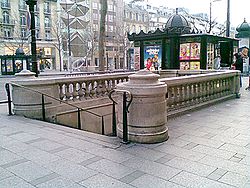
Neoclassical architecture
Neoclassical architecture was an architectural style produced by the neoclassical movement that began in the mid-18th century, manifested both in its details as a reaction against the Rococo style of naturalistic ornament, and in its architectural formulas as an outgrowth of some classicizing...
stonework. These can be found near certain important monuments, including the Opéra
Opéra (Paris Metro)
Opéra is a station of the Paris Métro, named after the nearby Opera Garnier, built by the architect Charles Garnier. It is located at the end of the Avenue de l'Opera, one of the accesses being opposite the Opera, and serves the district of the Boulevard Haussmann...
, the Madeleine
Madeleine (Paris Metro)
Madeleine is a station on lines 8, 12 and 14 of the Paris Métro in central Paris and the 8th arrondissement.The station was opened on 5 November 1910 as part of the original section of the Nord-Sud Company's line A between Porte de Versailles and Notre-Dame-de-Lorette. On 27 March 1931 line A...
and on the Champs-Elysées
Champs-Élysées
The Avenue des Champs-Élysées is a prestigious avenue in Paris, France. With its cinemas, cafés, luxury specialty shops and clipped horse-chestnut trees, the Avenue des Champs-Élysées is one of the most famous streets and one of the most expensive strip of real estate in the world. The name is...
.
After the end of the Belle Epoque
Belle Époque
The Belle Époque or La Belle Époque was a period in European social history that began during the late 19th century and lasted until World War I. Occurring during the era of the French Third Republic and the German Empire, it was a period characterised by optimism and new technological and medical...
, new entrances were entrusted to various architects. These typically feature cast-iron balustrades in an elegant but sober style. Elements of ceramique can be found in entrances on the two Nord-Sud lines.
Special cases
A few entrances, for example at PelleportPelleport (Paris Metro)
Pelleport is a station of the Paris Métro, serving Line 3bis. It was opened on 27 November 1921 when Line 3 was extended from Gambetta to Porte des Lilas. On 27 March 1971 it was transferred to Line 3bis on its establishment....
and Volontaires
Volontaires (Paris Metro)
Volontaires is a station on line 12 of the Paris Métro in the 15th arrondissement. It is located at the junction of the Rue des Volontaires with the Rue de Vaugirard....
, are housed in independent buildings. These are generally concrete constructions, and recall the architectural styles of the 1920s
1920s
File:1920s decade montage.png|From left, clockwise: Third Tipperary Brigade Flying Column No. 2 under Sean Hogan during the Irish Civil War; Prohibition agents destroying barrels of alcohol in accordance to the 18th amendment, which made alcoholic beverages illegal throughout the entire decade; In...
and 1930s
1930s
File:1930s decade montage.png|From left, clockwise: Dorothea Lange's photo of the homeless Florence Thompson show the effects of the Great Depression; Due to the economic collapse, the farms become dry and the Dust Bowl spreads through America; The Battle of Wuhan during the Second Sino-Japanese...
. Conversely, a number of entrances (Riquet
Riquet (Paris Metro)
Riquet is a station of the Paris Métro. It was named after French engineer Pierre-Paul Riquet , who conceived and carried out the construction of the Canal du Midi from 1666. This work was completed by his sons in 1681....
, Pernety
Pernety (Paris Métro)
Pernety is a station on line Line 13 of the Paris Métro in the 14th arrondissement.The station opened on 21 January 1937 as part of the original line 14 between Bienvenüe and Porte de Vanves...
) are built into the ground floor of existing buildings.
Signposts
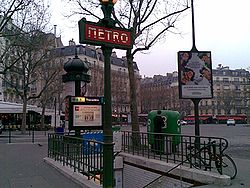
In the early years, two styles arrived in succession. The Val d'Osne variant (named after an iron foundry, and visible at Saint Paul
Saint-Paul (Paris Metro)
Saint-Paul is a station on Paris Métro Line 1. It serves the neighbourhood of Le Marais, known for its Jewish and gay communities. The Jewish quarter is called Pletzl and is located around the Rue des Rosiers...
) consists of a globe-shaped lamp atop a "MÉTRO" sign surrounded by an ornate cast-iron frieze. The simpler Dervaux lampposts (named after their architect) became common in the 1930s, following the contemporary trend away from decorative embellishment.
After the war, new Métro totems lost their lamps and became progressively simpler. The 1950s style features a the familiar "MÉTRO" against a blue ring and a large red "M". In the 1960s the blue ring was replaced by two stainless steel rings. Subsequent masts have kept these rings, now framing a simple interior-lit yellow "M".
Masts built since 1998 on line 14 are almost entirely novel, featuring a minimalist two-dimensional design but containing a hint of the original Guimard style in their plant-like verticals.
Ticket halls and corridors
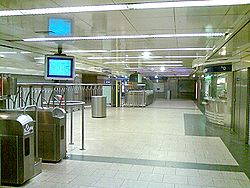
1970s
File:1970s decade montage.png|From left, clockwise: US President Richard Nixon doing the V for Victory sign after his resignation from office after the Watergate scandal in 1974; Refugees aboard a US naval boat after the Fall of Saigon, leading to the end of the Vietnam War in 1975; The 1973 oil...
shops appeared in certain stations where space permitted (for instance, Franklin D Roosevelt
Franklin D. Roosevelt (Paris Metro)
Franklin D. Roosevelt is a station of the Paris Métro serving both Lines 1 and 9. With 12.19m passengers annually, Franklin D. Roosevelt is the fourteenth busiest station in the Paris Métro system.-History:...
).
Corridors which connect platforms of different lines can be somewhat long. Near-surface construction means that tracks and corridors must follow the streets above, and often connecting lines are situated under perpendicular streets. Only a few stations (for example, Jussieu
Jussieu (Paris Metro)
Jussieu is a station on lines 7 and 10 of the Paris Métro in the eastern part of the Latin Quarter in the 5th arrondissement.The station was opened on 26 April 1931 with the extension of line 7 from Pont de Sully to Place Monge and its incorporation of part of Line 10 from Place Monge to Porte de...
) feature the cross-platform interchange
Cross-platform interchange
A cross-platform interchange is a type of interchange between different lines in a metro system. The term originates with the London Underground; such layouts exist in other networks but are not commonly so named...
common to deep underground networks.
Stairways are built to a rigorous standard (steps 30 cm deep and 16 cm high) in order to avoid irregularity, often the cause of accidents.
Escalator
Escalator
An escalator is a moving staircase – a conveyor transport device for carrying people between floors of a building. The device consists of a motor-driven chain of individual, linked steps that move up or down on tracks, allowing the step treads to remain horizontal.Escalators are used around the...
s made their appearance at Père-Lachaise
Père Lachaise (Paris Metro)
Père Lachaise is a station of the Paris Métro, serving line 2 and 3 on the border of the 11th and 20th arrondissements.The station was opened on 31 January 1903 as part of the extension of line 2 from Anvers to Bagnolet...
in 1909, and numbered around 15 by 1930. Today over 200 stations are equipped with escalators. In general they only ascend — to the ticket hall, to the street or both in busy stations. Moving walkways similar to those in airports have been installed in the two largest transfer stations where some transfers require walking a considerable distance, Châtelet
Châtelet (Paris Metro)
Châtelet is a station on lines 1, 4, 7, 11 and 14 of the Paris Métro in the centre of medieval Paris and the 1st arrondissement. The station is made up of two parts connected by a long corridor:...
and Montparnasse – Bienvenüe. At the latter station, a high-speed walkway was in brief operation but has since reverted to normal speed.
Elevators were first installed at République
République (Paris Metro)
République is a station of the Paris Métro, serving lines 3, 5, 8, 9, and 11.The station opened on 19 October 1904 as part of the first section of line 3 between Père Lachaise and Villiers. The line 5 platforms opened on 15 November 1907 with the extension of the line from Jacques Bonsergent to...
in 1910, following a convention by which the CMP agreed to build them where platforms were situated deeper than 12m below street level. They are in constant use only at a handful of deep stations, notably Abbesses
Abbesses (Paris Metro)
Abbesses is a station on Paris Métro Line 12, in the Montmartre district and the 18th arrondissement. Abbesses is one of the few deep stations of Paris métro, at 36 metres below ground, as it is located on western side of the butte of Montmartre...
(36m below street level) and Buttes-Chaumont
Buttes Chaumont (Paris Métro)
Buttes Chaumont is a station on 7bis of the Paris Métro in the 19th arrondissement, on the Avenue Simon Bolivar, near the Parc des Buttes Chaumont, which it is named after....
(28.7m).
Automatic crowd-control gates known as portillons automatiques were once present in the majority of stations at the end of the corridors leading to the platforms. Introduced from the 1920s to regulate passenger access to crowded platforms, their usefulness was never properly demonstrated and from the 1960s they were withdrawn from service. Most have been dismantled, but non-functioning examples can still be found at Charles de Gaulle – Étoile and Gare d'Austerlitz
Gare d'Austerlitz (Paris Metro)
The gare d'Austerlitz is a station on the Paris Métro, serving line 5 and forming the eastern terminus of line 10 in the 5th and the 13th arrondissements. The Line 5 station is open to the exterior though under the roof of the mainline Gare d'Austerlitz...
.
Train halls
Most Paris Métro stations were built underground near the surface, and are vaulted. Certain stations were built by the cut-and-cover method, with either iron or concrete roofs. Finally, a number of stations are situated above ground on viaducts.Vaulted stations generally comprise two platforms surrounding two central tracks. Exceptions include:
- Stations on one-way, "looped" stretches of track, with a single track and platform (example: Église d'AuteuilÉglise d'Auteuil (Paris Metro)Église d'Auteuil is a station of the Paris Métro in the 16th arrondissement, serving Line 10 . With around 150,000 passengers per year, it is the least-used station on the Paris Métro network.-Location:...
) - Stations that have two platforms, one for each direction, but whose platforms are housed in separate vaults that are not directly opposite each other, typically because the station is situated under narrow streets (example: LiègeLiège (Paris Metro)Liège is a station on line 13 of the Paris Métro on the border of the 8th and 9th arrondissements.It was built as part of the Nord-Sud Company's Line B from Saint-Lazare to Porte de Saint-Ouen and opened on 26 February 1911 as Berlin, named after the nearby Rue Berlin...
) - Terminus stations with 3 or 4 tracks and platforms (example: Porte de la ChapellePorte de la Chapelle (Paris Metro)Porte de la Chapelle is a station on line line 12 of the Paris Métro in the districts of La Chapelle and Goutte d'Or and the 18th arrondissement....
) - Stations where two lines share a single platform (example: La Motte-Picquet – GrenelleLa Motte-Picquet - Grenelle (Paris Metro)La Motte-Picquet Grenelle is a station of the Paris Métro, at the interconnection of lines 6, 8 and 10 in the 15th arrondissement, near the 7th arrondissement. The station combines underground and elevated platforms. It is named after the Avenue de la Motte-Picquet and the Boulevard de Grenelle...
)
The great majority of Paris metro stations have the same physical characteristics. The classic station vault is 14.1m wide and 5.9m high, including a 0.7m-thick sill on which the rails are laid. Platforms are 4m wide and separated by a 5.3m gap. The walls of the stations are slightly curved and their overall shape is elliptical.
Stations on today's line 12, and some of the northern stations on line 13 (Saint-Lazare to Porte de Clichy and Porte de Saint-Ouen) were originally built by a competing company, called the Companie du Nord-Sud, and are physically slightly different. These former Nord-Sud stations are larger, allowing for straight walls up to the point where the curvature of the vault begins, and the ceilings are higher, which provided room for overhead catenaries that have since been removed.
Other stations on the network depart from the classic standard, and have flat rather than vaulted roofs. Flat-roofed train halls are of two common types. Early stations built by cut-and-cover (due to tracks being less than 7m below the surface) typically feature roofs of metal beams, which in turn support miniature brickwork vaulting (as at Champs-Élysées — Clemenceau
Champs-Élysées - Clemenceau (Paris Metro)
Champs-Élysées – Clemenceau is a station on lines 1 and 13 of the Paris Métro in the 8th arrondissement.The stations platforms and access tunnels lie beneath Avenue des Champs-Élysées and Place Clemenceau. It is one of the eight original stations opened as part of the first section of line 1...
on Line 1). The standard hall width is 13.5m. A second type of cut-and-cover train hall is found in suburban stations built after the Second World War, and has a pure rectangular cross-section and reinforced concrete construction (Porte de Vanves
Porte de Vanves (Paris Metro)
Porte de Vanves is a station on line 13 of the Paris Métro and a stop on tramway line 3.The station was opened on 21 January 1937 on old Line 14, which was absorbed into 13 in 1976. It was the southern terminus of the line until its extension to Châtillon - Montrouge on 9 November 1976. In 2006,...
).
Elevated stations are the signature feature of lines 2 and 6. They are supported by iron columns
Wrought iron
thumb|The [[Eiffel tower]] is constructed from [[puddle iron]], a form of wrought ironWrought iron is an iron alloy with a very low carbon...
, of which the exterior masonry
Masonry
Masonry is the building of structures from individual units laid in and bound together by mortar; the term masonry can also refer to the units themselves. The common materials of masonry construction are brick, stone, marble, granite, travertine, limestone; concrete block, glass block, stucco, and...
features decorative motifs — of the Paris municipality and various wreaths and cornucopia
Cornucopia
The cornucopia or horn of plenty is a symbol of abundance and nourishment, commonly a large horn-shaped container overflowing with produce, flowers, nuts, other edibles, or wealth in some form...
. Stations on line 2 are covered by platform awnings, while those on line 6 have full glass roofs and opaque brick walls decorated on the outside with geometric motifs.
The original train hall length was 75m, though this has been extended to 90m on busy lines (1, 3, 7, 8, 9) to allow for 6-car trains. Certain stations were further extended to 105m, the difference as yet being unused.
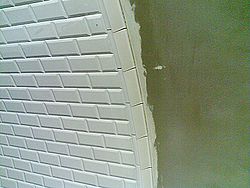

Original CMP style (1900–1914)
The original decoration of the Métro's underground train halls was austere. Stations featured plain white tiles, enamel plaques for the station name, a few wooden benches and the station manager's kiosk in the middle of the platform. Within a few years advertising billboards and confectionery machines appeared. The now-famous beveled white tiles (of GienGien
Gien is a commune in the Loiret department in north-central France.Gien is on the Loire River, from Orléans. The town was bought for the royal property by Philip II of France. The town is twinned with Malmesbury in England.-Sights:*Faience de Gien...
earthenware) were chosen for their effective reflection of ambient light. The turn-of-the-century electric lighting had a strength of only 5 lux
Lux
The lux is the SI unit of illuminance and luminous emittance, measuring luminous flux per unit area. It is used in photometry as a measure of the intensity, as perceived by the human eye, of light that hits or passes through a surface...
, making it impossible to read a book.
Nord-Sud Style (1910–1930)
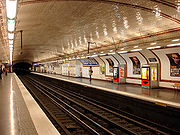
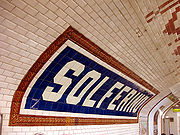
Madeleine (Paris Metro)
Madeleine is a station on lines 8, 12 and 14 of the Paris Métro in central Paris and the 8th arrondissement.The station was opened on 5 November 1910 as part of the original section of the Nord-Sud Company's line A between Porte de Versailles and Notre-Dame-de-Lorette. On 27 March 1931 line A...
(the reason for this station's particular color scheme has never been fully explained). These colors matched the colors of the tile borders on the station's poster frames, nameplates and corridors. The most impressive feature of the Nord-Sud stations were the station names themselves, executed in large tile mosaics with white letters on a blue background. Blue and white tiling above the two tunnel entrances also indicated the destination of the trains (for example, "Dir. Montparnasse / Dir. Montmartre" on line 12). Today, only a few stations—Solférino
Solférino (Paris Metro)
Solférino is a station on Line 12 of the Paris Métro in the 7th arrondissement.The station opened on 5 November 1910 as part of the original section of the Nord-Sud Company's line A between Porte de Versailles and Notre-Dame-de-Lorette. On 27 March 1931 line A became line 12 of the Métro...
, Liège
Liège (Paris Metro)
Liège is a station on line 13 of the Paris Métro on the border of the 8th and 9th arrondissements.It was built as part of the Nord-Sud Company's Line B from Saint-Lazare to Porte de Saint-Ouen and opened on 26 February 1911 as Berlin, named after the nearby Rue Berlin...
, Porte de Versailles
Porte de Versailles (Paris Metro)
Porte de Versailles is a station on line 12 of the Paris Métro and a stop on tramway lines 2 and 3.The station was opened on 5 November 1910 as part of the stage of the Nord-Sud Company's line C from Porte de Versailles to Notre-Dame-de-Lorette. The line was taken over by the metro in 1930 and...
, Porte de la Chapelle
Porte de la Chapelle (Paris Metro)
Porte de la Chapelle is a station on line line 12 of the Paris Métro in the districts of La Chapelle and Goutte d'Or and the 18th arrondissement....
, Porte de Clichy, and Pasteur
Pasteur (Paris Metro)
Pasteur is a station on lines 6 and 12 of the Paris Métro in the 15th arrondissement. The platforms on both lines are underground, although line 6 becomes elevated just to the northwest of the station. Nearby are the Pasteur Institute and the Lycée Buffon .-History:The station opened on 24 April...
—retain much of their original Nord-Sud tiling, with Solférino the most intact example. Others, including Sèvres-Babylone
Sèvres - Babylone (Paris Metro)
Sèvres-Babylone is a station on lines 10 and 12 of the Paris Métro. It is located at the intersection of the Boulevard Raspail and the Rue de Sèvres, on the border of the 6th arrondissement and 7th arrondissements, near le Bon Marché department store....
, Notre-Dame-des-Champs, and Lamarck – Caulaincourt
Lamarck - Caulaincourt (Paris Metro)
Lamarck — Caulaincourt is a station on Line 12 of the Paris Métro in the Montmartre district and the 18th arrondissement of Paris.-Location:...
have undergone renovations to restore the Nord-Sud decoration destroyed in earlier renovations.
CMP Interwar Style (1916–1950)
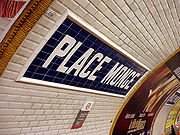
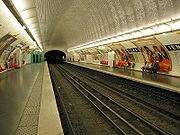
Porte d'Auteuil (Paris Metro)
Porte d'Auteuil is a métro station serving Line 10 . It is situated in the 16th arrondissement.- History :The station opened on 30 September 1913 as part of the extension of line 8 from Beaugrenelle...
and Opéra
Opéra (Paris Metro)
Opéra is a station of the Paris Métro, named after the nearby Opera Garnier, built by the architect Charles Garnier. It is located at the end of the Avenue de l'Opera, one of the accesses being opposite the Opera, and serves the district of the Boulevard Haussmann...
, and in the newly-constructed (in 1916) line 7 stations Pyramides
Pyramides (Paris Metro)
Pyramides is a station of the Paris Métro. It is named after the Rue des Pyramides, which commemorates the victory in 1798 of Napoleon Bonaparte's Armée d’Orient over the Mamluks of Murad Bey in the Battle of the Pyramids in Egypt. The line 7 station opened in 1916 and the line 14 station was...
and Palais-Royal. The CMP rolled out its new signage in 1921 in three newly-built line 3 (now line 3bis) stations from Gambetta
Gambetta (Paris Metro)
Gambetta is a station of the Paris Métro. It serves Line 3 and is the southern terminus of Line 3bis. It was opened on 25 January 1905 when the line was extended from Père Lachaise and was the eastern terminus of the line until 27 November 1921, when the line was extended to Porte des Lilas...
to Porte des Lilas
Porte des Lilas (Paris Metro)
Porte des Lilas is a station of the Paris Métro. It serves Line 11 and is the northern terminus of Line 3bis.The station was opened on 27 November 1921 when Line 3 was extended from Gambetta to Porte des Lilas. The line 11 platforms opened as part of the original section of the line from Châtelet...
. Primarily, the CMP borrowed the Nord-Sud's idea of station names executed in blue and white earthenware tiles (which was also cheaper than equipping every station with enamel). At up to two meters long, the new nameplates were smaller than those of the Nord-Sud, but the CMP increased their number along the length of the platforms for an average of six to eight on each platform. The CMP also tiled its poster frames with more elaborately decorated borders of ochre faience, featuring floral and organic motifs.
Toward the end of the 1930s and in the 1940s, the CMP introduced geometric, Art Deco-inspired tiling for corridor friezes and poster frames. The comparatively small number of stations that received this decorative treatment, coupled with subsequent renovations, means that there are very few stations that still have this tiling. Nevertheless, it can still be viewed at Laumière
Laumière (Paris Metro)
Laumière is a station of the Paris Métro, serving line 5.The name refers to the Avenue de Laumière, named for Xavier Jean-Marie Clément Vernhet de Laumière, a general who was killed in the French intervention in Mexico in the 19th century....
, Pierre and Marie Curie, and a few other stations.
Carrossage (metal paneling) (1952–1968)
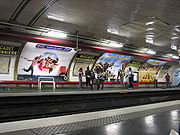
Fluorescent lamp
A fluorescent lamp or fluorescent tube is a gas-discharge lamp that uses electricity to excite mercury vapor. The excited mercury atoms produce short-wave ultraviolet light that then causes a phosphor to fluoresce, producing visible light. A fluorescent lamp converts electrical power into useful...
introduced in the 1950s
1950s
The 1950s or The Fifties was the decade that began on January 1, 1950 and ended on December 31, 1959. The decade was the sixth decade of the 20th century...
. Starting in 1952, a series of pilot renovations were carried out. These consisted of renovating stations by applying sheaths of metal paneling (known as ) along the sides of the stations, hiding the aging tilework. This proved to be cheaper than refurbishing the tile and increased the amount of space available for advertising posters whose revenues contributed to financing the renovation.
Franklin D Roosevelt
Franklin D. Roosevelt (Paris Metro)
Franklin D. Roosevelt is a station of the Paris Métro serving both Lines 1 and 9. With 12.19m passengers annually, Franklin D. Roosevelt is the fourteenth busiest station in the Paris Métro system.-History:...
on line 9 received the first paneling makeover, to be followed by several other stations, each featuring slightly different prototypes: Saint-Paul
Saint-Paul (Paris Metro)
Saint-Paul is a station on Paris Métro Line 1. It serves the neighbourhood of Le Marais, known for its Jewish and gay communities. The Jewish quarter is called Pletzl and is located around the Rue des Rosiers...
on line 1, Opéra
Opéra (Paris Metro)
Opéra is a station of the Paris Métro, named after the nearby Opera Garnier, built by the architect Charles Garnier. It is located at the end of the Avenue de l'Opera, one of the accesses being opposite the Opera, and serves the district of the Boulevard Haussmann...
and République
République (Paris Metro)
République is a station of the Paris Métro, serving lines 3, 5, 8, 9, and 11.The station opened on 19 October 1904 as part of the first section of line 3 between Père Lachaise and Villiers. The line 5 platforms opened on 15 November 1907 with the extension of the line from Jacques Bonsergent to...
on line 3, and Chaussée d'Antin
Chaussée d'Antin - La Fayette (Paris Metro)
Chaussée d'Antin - La Fayette is a station on Line 7 and Line 9 of the Paris Métro. The station was opened on 5 November 1910 with the opening of the first section of the line from Opéra to Porte de la Villette...
and Franklin D. Roosevelt
Franklin D. Roosevelt (Paris Metro)
Franklin D. Roosevelt is a station of the Paris Métro serving both Lines 1 and 9. With 12.19m passengers annually, Franklin D. Roosevelt is the fourteenth busiest station in the Paris Métro system.-History:...
on line 1. Public reception was favourable, and so the programme was extended to many other stations, with the prototype at République becoming the standard after some further slight modifications. The standard style eventually adopted throughout the network featured cream paneling and forest green accents, with brown enamel nameplates. Between 1960 and 1968 approximately 70 stations were paneled in this style. Because the Nord-Sud had used different sized advertising poster frames than the CMP in constructing its stations, carrossage also presented an opportunity to harmonize the poster frames on those lines with the rest of the network. All but seven stations on lines 12 and 13 received the carrossage makeovers.
But paneling had serious drawbacks that quickly became apparent. It used space on the platforms, making stations feel noticeably more cramped, and it rendered maintenance of the underlying tilework difficult. The paneling is currently being removed as part of the Renouveau du Métro programme. As of 2009, a few carrossage stations remain on lines 3, 4 and 12, and all are scheduled for replacement in the next few years.
Mouton-Duvernet Style (1968–1973)
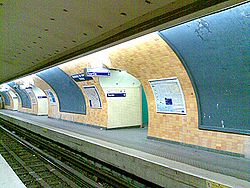

1960s
The 1960s was the decade that started on January 1, 1960, and ended on December 31, 1969. It was the seventh decade of the 20th century.The 1960s term also refers to an era more often called The Sixties, denoting the complex of inter-related cultural and political trends across the globe...
, with the renovation style known as Mouton-Duvernet (this station
Mouton-Duvernet (Paris Metro)
Mouton-Duvernet is a small, typically Parisian metro station on line 4 in the 14th arrondissement.The line 4 platforms were opened on 30 October 1909 when the southern section of the line opened between Raspail and Porte d'Orléans. The name refers to the Rue Mouton-Duvernet, named after...
on line 4
Paris Metro Line 4
Line 4 is one of the sixteen lines of the Paris Métro rapid transit system. Situated entirely within the boundaries of the City of Paris, it connects Porte de Clignancourt in the north and Porte d'Orléans in the south, travelling across the heart of the city. As a result, it is sometimes called...
being the first concerned).
The style's signature was the warm and dynamic colour orange, in variegated shades. Flat (non-bevelled) orange tiles covered the station walls but not the roof, which was simply painted in a neutral (and often dark) tone. The fluorescent-light housing, placed over the train tracks, was rectilinear and coloured in matching orange.
Around 20 stations were renovated in this way between 1968 and 1973, including Étoile, Oberkampf
Oberkampf (Paris Metro)
Oberkampf is a station of the Paris Métro, serving Line 5 and Line 9.The station was opened on 15 January 1907, a month after the opening of the extension of line 5 from Quai de la Rapée to Lancry on 17 December 1906...
Raspail
Raspail (Paris Metro)
Raspail is a station of the Paris Métro, serving Line 4 and Line 6 in the 14th arrondissement. The station is currently undergoing renovation works....
and Commerce
Commerce (Paris Metro)
Commerce is a station on line 8 of the Paris Métro in the Rue du Commerce, at the intersection with the Place du Commerce in the 15th arrondissement....
.
The Mouton-Duvernet aesthetic was intended to lend warmth and colour to hitherto plain station interiors. It was also self-consciously modern, a product of its iconoclastic era. Like some other artefacts
Brutalist architecture
Brutalist architecture is a style of architecture which flourished from the 1950s to the mid 1970s, spawned from the modernist architectural movement.-The term "brutalism":...
of the 1960s
1960s
The 1960s was the decade that started on January 1, 1960, and ended on December 31, 1969. It was the seventh decade of the 20th century.The 1960s term also refers to an era more often called The Sixties, denoting the complex of inter-related cultural and political trends across the globe...
, it dated poorly. The orange tones were quickly perceived as garish and aggressive, and the overall aesthetic as rather gloomy because the vault remained in shadow and the orange tiles did not reflect light as well as the white. The style is being withdrawn in the context of the Renouveau du Métro programme.
Andreu-Motte Style (1974–1986)

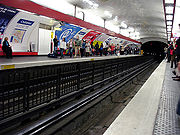
Paul Andreu
Paul Andreu is a renowned French architect. He is best known for having planned numerous airports worldwide, notably Ninoy Aquino International Airport , Soekarno-Hatta International Airport , Shanghai Pudong International Airport Abu Dhabi International Airport, Dubai International Airport,...
, prevailed in station renovations between 1974 and 1984 and affected around 100 stations. It represented a compromise between colourful innovation and the classic white aesthetic of the Métro.
Where the existing beveled tile was in good repair, the Andreu-Motte style was applied over the original tile, but in stations where more extensive tile replacement was called for, the beveled tiling was replaced by flat white rectangular tiles. To introduce color into the stations, a coordinated colour scheme was added to elements of the train hall — the seating, light housings, and walls of connecting corridors. Five main colour schemes were used: yellow, red, green, blue and orange. An aim was to facilitate subliminal recognition of stations by passengers, since particular stations took on colour identities — for example, Ledru-Rollin
Ledru-Rollin (Paris Metro)
Ledru-Rollin is a station on line 8 of the Paris Métro, named after the Avenue Ledru-Rollin.The station opened on 5 May 1931 with the extension of the line from Richelieu - Drouot to Porte de Charenton...
is blue and Voltaire
Voltaire (Paris Metro)
Voltaire is a station on line 9 of the Paris Métro. The station is located in the Place Léon Blum along with the town hall of the 11th arrondissement, which serves a lively district....
yellow.
The other innovation was a tiled ledge along the base of the station wall, in the station's signature colour. On this were placed individual seats in a sculpted single-piece style which has since become closely associated with the Métro. These seats, also called Motte seats, were ultimately introduced throughout the métro network, even in stations not renovated in the Motte style.
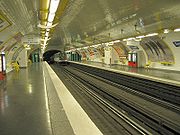
Ouï-dire Style (1986–1988)
The most recent genuinely original style used in renovations of early Métro stations is known as Ouï-dire ("Hearsay"), after the design firm responsible for the design. Beginning with StalingradStalingrad (Paris Metro)
Stalingrad is a Paris Métro station on the border between the 10th arrondissement and the 19th arrondissement at the intersection of lines 2, 5, and 7, located at the Place de Stalingrad, which is named for the Battle of Stalingrad.-History:...
(line 7
Paris Metro Line 7
Paris Métro Line 7 is one of sixteen lines of the Paris Métro system. Crossing the capital from its north-eastern to south-eastern sections via a moderately curved path, it links La Courneuve – 8 Mai 1945 in the north with Mairie d'Ivry and Villejuif – Louis Aragon in the south, while passing...
) in 1988, around 30 stations were decorated in this style. Ouï-dire's main component was a new light housing, cradled by distinctive scythe-shaped supports. Its hidden upper side projected light through colored filters directly onto the ceiling of the vault, illuminating it in a rainbow of multiple colors (over years of exposure to the ultraviolet fluorescent light, however, the colored refractory panels have progressively lost their color). The style initially featured distinctive seating complemented by high, "sit-lean" benches, but these fixtures proved difficult and costly to maintain and in many cases were replaced by standard Motte-style seating in the 1990s. The tiling in almost all of the Ouï-dire stations was replaced by the flat white Motte rectangular tiles. As with the Motte renovations, three distinct color schemes (red, yellow and green) were put into place, with chairs and poster frames built in matching colors, but the effect was more subtle than the use of color in the Motte stations.
Météor Style (1998–present)
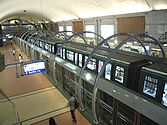
Paris Metro Line 14
Line 14 of the Paris Métro system connects the stations Saint Lazare and Olympiades on a north-west south-east diagonal across the centre of Paris. It is the twelfth busiest of sixteen lines on the network, and as of 2011, the only one to be operated completely automatically; the second such line...
(originally known as Météor) represented a blank slate for station decoration. Following the logic of the stations' capacious volumes, the RATP opted for minimalism
Minimalism
Minimalism describes movements in various forms of art and design, especially visual art and music, where the work is set out to expose the essence, essentials or identity of a subject through eliminating all non-essential forms, features or concepts...
, with an emphasis on space, light and modernity. Specifically, the stations should represent "a noble public space, monumental in spirit, urbane in its choice of shapes and materials."
In practical terms, this meant a diversity of materials. Walls are panelled in steel, stone and even frosted glass, while platform floors are marbelled. Elsewhere, the dominant surface is polished bare concrete.
The first seven stations of the line were designed by Jean-Pierre Vaysse, Bernard Kohn, Antoine Grumbach
Antoine Grumbach
Antoine Grumbach is a French architect who amongst others designed Disney's Sequoia Lodge hotel at Disneyland Resort Paris.-References:...
and Pierre Schall.
Bruno-Gaudin (1996–present)
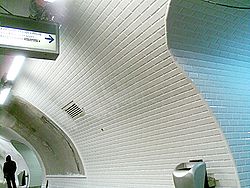
This extremely successful style has been followed by the RATP in all of the major station renovations undertaken since 1999 as part of the Renouveau du Métro program. The style also lends itself to both minor and major renovation schemes. In stations that have the beveled tile already, renovation in Bruno-Gaudin style is fairly straightforward; other stations have been entirely retiled in the classic white tile to bring them into conformity with this style. In some stations, the Bruno-Gaudin wave light fixture cannot be used due to the particularities of the vault or, in the case of stations with Nord-Sud decor, because it would obscure particular decorative features. For these cases, the RATP has developed a secondary type of lighting fixture consisting of a long, compact tube of extremely luminescent fluorescent light that is suspended from the ceiling of the vault, over the train tracks, rather than being attached to the walls of the vault itself. This light fixture has the benefit of being as bright as the Gaudin model, but is very discreet.
Station renovation programme (Renouveau du Métro)

The program involves:
- Replacing and standardising the tiling of stations. Beveled tile and flat Motte tile in good condition has been retained. Tile in poor condition, and the orange tile of the Mouton stations, has been replaced with fresh beveled white tile. Tile renovation has often included the installation of sub-surface drains to control future water infiltrations, the source of unsightly stains on the ceiling and sides of the vaults and in corridor areas.
- Replacing lighting, mainly with the Bruno-Gaudin "wave" model or the suspended tube model.
- Removing or hiding exposed pipes and electrical cables.
- Replacing the Univers signage with Parisine signage and updating direction indicators, in tandem with the electronic train arrival boards known as the SIEL system (le Service d'Information d'attente En Ligne, or Line Waiting Information Service).
Signage and Typography

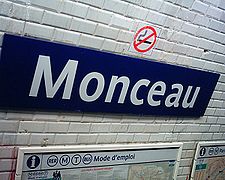
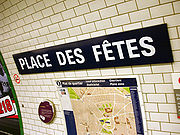
Stations that were modernized in the carossage style of the 1950s and 1960s received new station signage. Breaking with the blue-and-white used for both tile and enamel nameplates until that time, the nameplates installed in carossage stations featured bright yellow, uppercase, sans-serif letters on a dark brown background, which actually proved to be more difficult to read from inside the trains.
In the early 1970s, spurred on by the development of the RER stystem and by the opening of several new extensions on the network, the RATP undertook a program to harmonize the metro's corporate identity by replacing the many different fonts then in use with a unified, standard typeface. The font eventually chosen, "Métro Alphabet," was developed by the Swiss typeface designer Adrian Frutiger
Adrian Frutiger
Adrian Frutiger is one of the prominent typeface designers of the 20th century, who continues to influence the direction of digital typography in the 21st century; he is best known for creating the typefaces Univers and Frutiger.-Early life:Adrian Frutiger was born in Unterseen, Canton of Bern, as...
as a special, modified version of his Univers
Univers
Univers is the name of a realist sans-serif typeface designed by Adrian Frutiger in 1954.Originally conceived and released by Deberny & Peignot in 1957, the type library was acquired in 1972 by Haas. Haas'sche Schriftgiesserei was later folded into the D...
typeface. Installed throughout the network between 1973 and 1994, Métro Alphabet became the most widespread font used on the system and still remains in dozens of stations.
By the early 1990s, the RATP had decided to update its signage, and selected a variant of the widespread Helvetica
Helvetica
Helvetica is a widely used sans-serif typeface developed in 1957 by Swiss typeface designer Max Miedinger with Eduard Hoffmann.-Visual distinctive characteristics:Characteristics of this typeface are:lower case:square dot over the letter i....
typefice, Neue Helvetica, for use in stations and on maps. The first métro typeface to employ upper and lower case letters, it was only used in a handful of stations, notably Place d'Italie
Place d'Italie (Paris Metro)
Place d'Italie is a rapid transit station of the Paris Métro located in the heart of the 13th arrondissement of Paris, at the Place d'Italie. It is the terminus of Line 5 and is also served by Line 6 and Line 7.-History:...
on line 6, before the RATP changed course and commissioned French typeface designer Jean-François Porchez
Jean-François Porchez
Jean François Porchez is a French type designer. He was president of ATypI , the leading organisation of type designers from 2004 to 2007. He is probably best-known for releasing the new typefaces for Le Monde, the French evening newspaper in 1994...
to create an exclusive font for the system. Porchez's font, called Parisine
Parisine
Parisine is a typeface developed by Jean-François Porchez.It is used in Paris Métro, tramways, busses and RER parts operated by the RATP in Île-de-France.- Parisine :...
because it was initially used for the station signs, was first introduced in 1997. Since then, it has been adopted throughout the system and has increasingly replaced the remaining Frutiger signage.
Cultural Stations
Around 30 stations are decorated in entirely original ways, to celebrate particular themes.Louvre station (known since 1989 as Louvre – Rivoli
Louvre - Rivoli (Paris Metro)
Louvre Rivoli is a station on Paris Métro Line 1. It is near the Louvre and Rue de Rivoli.The station was opened on 13 August 1900, almost a month after trains began running on the original section of line 1 between Porte de Vincennes and Porte Maillot on 19 July 1900, under the name Louvre...
) was the first station to receive such a makeover, on the initiative of culture minister André Malraux
André Malraux
André Malraux DSO was a French adventurer, award-winning author, and statesman. Having traveled extensively in Indochina and China, Malraux was noted especially for his novel entitled La Condition Humaine , which won the Prix Goncourt...
in 1968. The platforms feature stonework, statues and other replica museum pieces, under subtle lighting, which together make the station into an antechamber of the Musée du Louvre. Until the reconstruction of the Louvre in the late 1980s, this station was the closest to the museum's entrance. When I. M. Pei
I. M. Pei
Ieoh Ming Pei , commonly known as I. M. Pei, is a Chinese American architect, often called a master of modern architecture. Born in Canton, China and raised in Hong Kong and Shanghai, Pei drew inspiration at an early age from the gardens at Suzhou...
's pyramid
Louvre Pyramid
The Louvre Pyramid is a large glass and metal pyramid, surrounded by three smaller pyramids, in the main courtyard of the Louvre Palace in Paris. The large pyramid serves as the main entrance to the Louvre Museum...
was added to the Louvre and made the central entrance at the end of the 1980s, the neighboring metro station Palais-Royal became the closest to the museum entrance; so close, in fact, that a subterranean corridor was constructed leading directly from the museum to the Palais-Royal station, which was renamed Palais-Royal – Musée du Louvre. As part of the change, Louvre station took on the name Louvre – Rivoli. Nevertheless, the resulting configuration—with the specially-decorated Louvre station at a further distance from the museum—is confusing.
Other stations were subsequently redecorated on the theme of the landmark situated above them or to reflect the cultural significance of the name of the station.
- Assemblée NationaleAssemblée Nationale (Paris Metro)Assemblée Nationale is a station on Line 12 of the Paris Métro in the 7th arrondissement, named after the nearby French National Assembly.The station opened on 5 November 1910 as part of the original section of the Nord-Sud Company's line A between Porte de Versailles and Notre-Dame-de-Lorette. On...
(line 12) has no advertising on the station walls, which are reserved for 90-meter long colorful murals, featuring silhouettes of deputies. Developed by Jean-Charles Blais, this decoration is changed with each renewal of the legislature. - ConcordeConcorde (Paris Metro)Concorde is a station on lines 1, 8 and 12 of the Paris Métro in the Place de la Concorde in central Paris and the 1st arrondissement.The station was opened on 13 August 1900, almost a month after trains began running on the original section of line 1 between Porte de Vincennes and Porte Maillot on...
(line 12) is completely tiled in the text of the August 1789 Declaration of the Rights of Man and the Citizen. The scheme was designed by Françoise Schein and executed in 1991. - Cluny—La SorbonneCluny - La Sorbonne (Paris Metro)Cluny - La Sorbonne is a station on line 10 of the Paris Metro in the 5th arrondissement. It is in the heart of the Latin Quarter and Paris' Left Bank.-History:...
(line 10), decorated when the station reopened after 50 years of closure in 1988, celebrates the writers of the Latin QuarterLatin QuarterLatin Quarter is a part of the 5th arrondissement in Paris.Latin Quarter may also refer to:* Latin Quarter , a British pop/rock band* Latin Quarter , a 1945 British film*Latin Quarter, Aarhus, part of Midtbyen, Aarhus C, Denmark...
, with a tiled reproduction of Les Oiseaux by Jean Bazaine. - BastilleBastille (Paris Metro)Bastille is a station on lines 1, 5 and 8 of the Paris Métro. It is located near the former location of the Bastille and remains of the Bastille can be seen on line 5. The platforms for line 1 are situated below road level but above the Basin of the Arsenal and Canal Saint Martin in a short-open...
features murals of scenes from the French RevolutionFrench RevolutionThe French Revolution , sometimes distinguished as the 'Great French Revolution' , was a period of radical social and political upheaval in France and Europe. The absolute monarchy that had ruled France for centuries collapsed in three years...
on line 1, and archeological remains of the notorious former prisonBastilleThe Bastille was a fortress in Paris, known formally as the Bastille Saint-Antoine. It played an important role in the internal conflicts of France and for most of its history was used as a state prison by the kings of France. The Bastille was built in response to the English threat to the city of...
on the platform of Line 5. - Arts et MétiersArts et Métiers (Paris Metro)Arts et Métiers is a station of the Paris Métro, serving Line 3 and Line 11. It takes its name from the Musée des Arts et Métiers, which is served by the station. It opened on 19 October 1904 as part of the first section of line 3 opened between Père Lachaise and Villiers...
(line 11), site of the "Arts and Crafts" school, is clad strikingly in copper to evoke the Jules-Verne-like interior of a submarine, a design by comic-book author François SchuitenFrançois SchuitenBaron François Schuiten is a Belgian comic book artist. He is best known for drawing the series Les Cités Obscures.-Biography:François Schuiten was born in Brussels, Belgium in 1956....
. It was executed in 1994. - Pont-NeufPont Neuf (Paris Metro)Pont Neuf is a station of the Paris Métro in the heart of old Paris and is connected to the Île de la Cité by the nearby Pont Neuf. It opened in 1926 with the extension of line 7 from Palais Royal - Musée du Louvre to Pont Marie....
– La Monnaie line 7), located near the MintMonnaie de ParisThe Monnaie de Paris or, more administratively speaking, the "Direction of Coins and Medals", is an administration of the French government charged with issuing coins as well as producing medals and other similar items. Many ancient coins are housed there...
, features sculptures of oversized coins "dropping" from the ceiling and walls. - LiègeLiège (Paris Metro)Liège is a station on line 13 of the Paris Métro on the border of the 8th and 9th arrondissements.It was built as part of the Nord-Sud Company's Line B from Saint-Lazare to Porte de Saint-Ouen and opened on 26 February 1911 as Berlin, named after the nearby Rue Berlin...
(line 13) has tile mosaics inserted into the former advertising frames featuring scenes of various locations in the old ecclesiastical principality of LiègeBishopric of LiègeThe Bishopric of Liège or Prince-Bishopric of Liège was a state of the Holy Roman Empire in the Low Countries in present Belgium. It acquired its status as a prince-bishopric between 980 and 985 when Bishop Notger, who had been the bishop of Liege since 972, acquired the status of Prince-Bishop...
. They were offered to Paris as a gift by Belgium in 1982. - CadetCadet (Paris Metro)Cadet is a station on Line 7 of the Paris Métro. It is named after Rue Cadet, itself named after M. Cadet de Chambine, owner of much land through which the street passes. The street was called Rue de la Voirie before being renamed. Numbers 9 and 11 are the old Hôtel Cromot du Bourg...
(line 7) is entirely tiled in the stars and stripes of the American flag. - ParmentierParmentier (Paris Metro)Parmentier is a station on Paris Métro Line 3. It was opened on 19 October 1904 as part of the first section of line 3 between Père Lachaise and Villiers....
(line 3) is a celebration of the potato. The station, named after the 18th-century French scientist Antoine-Augustin ParmentierAntoine-Augustin ParmentierAntoine-Augustin Parmentier is remembered as a vocal promoter of the potato as a food source in France and throughout Europe...
, who promoted the use of potato as a food source at the end of the 18th century, is a specially-modified version of the carrossage stations. It features green trellises instead of metal sheaths along the walls, tractor seats for benches, and exhibits about the potato.
A handful of stations were redecorated according to more general themes as part of the 2000 celebrations of the Métro's centenary.
- St-Germain-des-PrésSaint-Germain-des-Prés (Paris Metro)Saint-Germain-des-Prés is a station on line 4 of the Paris Métro, serving the Saint-Germain-des-Prés area in the heart of the Left Bank in the 6th arrondissement....
(line 4) presents projections of the musings of the neighbourhood's postwar philosophers. - EuropeEurope (Paris Metro)Europe is a station on Paris Métro Line 3.The station opened on 19 October 1904, nine days after the first section of Line 3 opened between Père Lachaise and Villiers. It is named after the Place d'Europe, a square from which streets named for various capitals of European countries radiate...
(line 3) marks European integration and cooperation - TuileriesTuileries (Paris Metro)Tuileries is a station on Paris Métro Line 1, situated in the 1st arrondissement of Paris.-Location:Like most stations on Line 1, Tuileries station lies on an east-west axis from La Défense in the west to Vincennes in the east...
(line 1) presents 20th century history and culture - Villejuif — Léo LagrangeVillejuif - Léo Lagrange (Paris Metro)Villejuif – Léo Lagrange is a station of the Paris Métro, located on Line 7. It serves the commune of Villejuif. It was opened when Line 7 was extended from Le Kremlin-Bicêtre to Villejuif – Louis Aragon on 28 February 1985...
(line 7) celebrates sport

